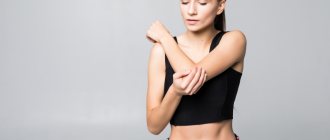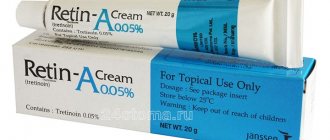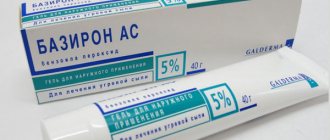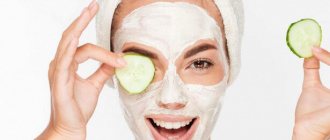From this article you will learn:
- indications for use in acne and pimples,
- instructions for use,
- reviews of drugs from the Klenzit line.
The article was written by a specialist with higher medical education.
Klenzit and Klenzit-S are a line of medications for external use (in the form of gels) that are intended for the treatment of acne and pimples. The main active component of these drugs is the retinoid adapalene 0.1%, which significantly reduces the hyperactivity of the sebaceous glands, normalizes the phenomena of follicular hyperkeratosis, and also has an anti-inflammatory effect.
But if the Klenzit gel contains only adapalene, then Klenzit-S, in addition to adapalene, also contains the antibiotic clindamycin 1%. The latter has antimicrobial activity against the bacteria Propionibacterium acnes (P.acnes) and Staphylococcus epidermidis (S.epidermidis), which play an important role in the formation of acne and pimples, such as comedones, papules or pustules.
Preparations Klenzit-S and Klenzit: photos
The drugs are produced by Indian pharmaceutical companies and are sold in pharmacies without a prescription. Age restrictions exist only for the Klenzit-S gel, which is recommended for use only in persons over 12 years of age. In this article, we will tell you about international protocols for the treatment of acne (acne and pimples), and you will be able to understand which of these drugs should be used specifically in your case, as well as for how long.
How much do the Klenzit line drugs cost in pharmacies:
The drugs are available in tubes of 15 and 30 g, but due to the fact that the treatment is long-term, it is irrational to buy small packages. For Klenzit gel, the price will be from 800 rubles (for a 30 g tube), and it is cheaper among drugs with 0.1% adapalene - in pharmacies with the same composition you can only find “Adaklin” for 550 rubles. But the latter is available only in the form of a cream, while gel forms of topical retinoids are more effective (with equal concentrations of adapalene).
Another similar drug, Differin, will cost from 900 rubles (30 g tube). As for the drug Klenzit-S, the price for it will be from 870 rubles. But we immediately want to warn you that incorrect prescription and use of the drug Klenzit-S can play a cruel joke and lead to the formation of antibiotic resistance in P.acnes bacteria. And in turn, this will certainly lead to a worsening of the disease in the long term.
Klenzit C for acne: composition
Klenzit C owes its effectiveness to adapalene and clindamycin. Acting comprehensively, they fight the cause of acne formation and help the skin recover after a long inflammatory process.
Clindamycin is an antibacterial agent, a member of the lincosamide group. Its wide spectrum of action prevents the synthesis of microbial protein, which brings about its inevitable death. After applying the substance to the skin, clindamycin phosphate is hydrolyzed in the sebaceous glands in a short period of time and actively fights microorganisms that form acne.
Adapalene is a derivative of vitamin A. It has a pronounced anti-inflammatory effect. It affects comedones of varying degrees of maturity and normalizes keratinization processes. Studies have shown that retinoic acid nuclear receptors are bound by adapalene, which explains the mechanism of action of the active substance. Adapalene restores the normal course of differentiation processes of follicular epithelial cells, reducing the number of micro comedones formed, and also suppresses the formation of inflammatory reactions.
Which patients will we prescribe Klenzit-S
- If you have acne (comedones), it makes no sense to prescribe this drug for acne, because in this case, only non-inflammatory elements (comedones/acne) will appear on the skin. In this case, we need regular Clenzit gel without antibiotic content. But the use of antibiotics in this case is not only pointless, but also harmful, because contributes to the emergence of antibiotic-resistant strains of the bacterium P.acnes. And then in the future, when you may be advised to use antibiotics, they will no longer be effective for you.
- If you have acne (mainly papules) - papules are inflammatory formations without pus inside, and according to the strategy of “treating the principle of clinical manifestations” (UpToDate 2009) - papules are optimally treated with a combination of “adapalene 0.1% + benzoyl peroxide”. Thus, in the morning you can use the drug Baziron AS, and in the evening before bed - the usual mono-component gel Clenzit with adapalene.
- If you have acne (pustules), the presence of pustules with pus suggests the unambiguous use of antibiotics as part of complex therapy.
If we have a mild or moderate severity of the disease, we will prescribe the patient Klenzit-S gel in the evening, and in the morning the drug Baziron AS (with benzoyl peroxide). If we have severe acne, we prescribe a combination: “oral antibiotic + Baziron AS in the morning + Clenzit gel in the evening before bed.” Remember that antibiotics themselves are quite ineffective, the effect of their use is not very long-lasting, and in addition, their use without the parallel use of benzoyl peroxide quickly leads to the formation of antibiotic-resistant strains of the bacterium P.acnes. In turn, this will lead to worsening of the clinical manifestations of your acne.
Important: please note that reducing the population of P.acnes bacteria is possible not only with the help of antibiotics. In this regard, the following methods will be very effective - phototherapy (IPL) using the Lumenis M-22 device, as well as photodynamic therapy. During these procedures, the cell walls of the P. acnes bacteria are destroyed, and in this way we can dramatically reduce the number of inflammatory elements on the skin - even without the use of antibiotics. Read more about light treatment methods at the link below:
→ International acne treatment protocols
Klenzit C: indications
The drug is prescribed for acne, which most often appears on the face of adolescents. Mainly during puberty, young people and girls begin to change their hormonal levels, and with it the functioning of all body systems. The sebaceous glands, especially on the face, work excessively during this period. If the pores become clogged during the day and there is no daily toilet of the skin, the accumulated sebum under the crusty plugs becomes an excellent breeding ground for the proliferation of bacteria. This is used by the microorganisms Propionibacterium acnes. They begin to actively multiply, thereby provoking the formation of foci of inflammation.
The presence of pus in a rash is always an indicator of the presence of bacteria, since pus is formed as a result of the appearance of microbial waste products. A rash with purulent contents on the face is a direct indication for contacting a specialist who will prescribe Klenzit C.
Clenzit C: instructions
The gel is used exclusively externally. Before application, it is necessary to rinse the skin, removing all visible contaminants, after which the surface should be dried. The product is applied with careful movements without damaging the inflamed areas. It is recommended to use the gel once a day, before bed.
It is important to avoid contact with eyes and lips, as the product is not intended for use on mucous membranes.
The effect does not become noticeable immediately. It will take at least 1 week before the appearance of the skin begins to improve. In some situations, the expected effect may occur after 4 weeks. A long recovery period is associated with the maturation period of acne. The destruction of bacteria is accompanied by the accumulation of purulent contents, which intensifies after the death of the microorganism.
Sustained remission is observed after 3 months. If symptoms return, you can repeat the course, but only after consultation with a specialist. You should not increase the dosage and amount of applied gel in order to speed up the onset of recovery, as this does not provide the expected effect, but only increases the risk of developing adverse reactions.
Who do we recommend Klenzit gel to?
This section is not our fabrications, but international protocols for the treatment of acne and pimples, which are described in detail in the most famous textbook on dermatology, Fitzpatrick's Dermatology.
- If you have acne – in this case, you will only have non-inflammatory elements (white or blackheads) on your facial skin. In this case, only monotherapy with Klenzit will be enough for you, but in addition, cleansers with salicylic acid or alpha hydroxy acids (24stoma.ru) will not hurt. The only thing we still want to warn you about is the side effects.
The fact is that in patients with dry and/or sensitive skin, topical retinoids in the form of gels can highly likely lead to skin irritation (even more dryness, redness, itching or burning). Therefore, in these types of patients it is better to use adapalene cream rather than a gel. Clenzit is not available in cream form, so we can recommend either Differin cream or Adaklin cream, which also contain adapalene.→ International acne treatment protocol
- If you have acne (papules and/or pustules) - in this case we will need combination therapy, which will differ depending on the predominance of papules or pustules. If you have mostly papules without pus, then we prescribe Klenzit gel once a day (in the evening before bed) + Baziron AS containing benzoyl peroxide once a day (in the morning). Benzoyl peroxide is an antimicrobial component.
But if you have papules with pus, then the situation changes, and in this case we will definitely need an antibiotic in the treatment regimen. For papulopustular acne of mild to moderate severity, antibiotics are prescribed externally. And in this case, it would be better to prescribe not Klenzit, but the drug Klenzit-S (it contains adapalene 0.1% and the antibiotic clindamycin 1%) - we prescribe it once a day in the evening before bed. Plus, in the morning we again prescribe Baziron AS with benzoyl peroxide to the patient.If we have a severe form of acne, then in this case antibiotics are prescribed only orally. In this case, in addition to antibiotics (read about them at the link below), we will prescribe Clenzit gel once a day in the evening before bed, and in the morning we will again prescribe Baziron AS with benzoyl peroxide.
→ International acne treatment protocol
How to apply the drug correctly. What course of treatment?
Clenzit can only be applied externally, avoiding lips, eyes and mucous membranes. This is done only once a day (before bedtime). It is important that before applying the product you cleanse your skin with a mild cleanser and dry it well, because... Application to wet skin will immediately lead to irritation. The drug is applied in a thin layer to areas of the face affected by acne and pimples. The drug is quite economical, and one 30 g tube will last you a long time.
When you see the result, patients with oily skin will notice almost on the second day that their skin has become much less oily. As for acne, the first visible result will be noticeable no earlier than 4 weeks from the start of therapy. A satisfactory result should be expected no earlier than after 8 weeks. A good lasting result is the field of completing the full course, which should last at least 3 months.
If you have acne, then we have already said that combination therapy is needed. If you use only Clenzit alone, the improvement of your acne will occur slowly (see the time frame for acne). But with combination therapy, for example, “Klensit + benzoyl peroxide” or “Klensit + benzoyl peroxide + antibiotic”, we will see the first results within 10-14 days.
Possible adverse reactions from Clenzit C
The following list of reactions may occur on the skin:
- dryness and flaking;
- burning at the site of application;
- dermatitis;
- swelling of the epidermis;
- hives.
An allergic reaction often manifests itself in the organ of vision in the form of swelling of the eyelids, itching, erythema and a burning sensation. In addition, reactions from the digestive system may occur in the form of abdominal pain, diarrhea or vomiting. If any side effect occurs, treatment is stopped or the dose is adjusted downwards.
Reception features
Treatment with Klenzit C gel is not prescribed to children under 12 years of age, as well as to expectant and nursing mothers. During the first few days of using the gel, acne may worsen. This is not a manifestation of adverse reactions. The abundant formation of pus is explained by the death of bacteria and the ripening of acne, without which it is impossible to achieve cleansing of the skin.
Clenzit C increases the skin's surface sensitivity to sunlight. In this regard, experts do not recommend being in the open sun during the period of gel treatment. It should also be borne in mind that negative reactions from the gastrointestinal tract do not always occur during use of the drug. Sometimes the first pain, nausea or diarrhea occurs 21 days after stopping treatment. If diarrhea is associated with treatment with Klenzit C, it is unacceptable to use drugs that stop intestinal motility to stop it.
The simultaneous use of systemic medications does not affect the effect of the gel, just as the active substances of Klenzit C do not in any way affect the course of treatment with drugs intended for oral administration, since they are practically not absorbed into the blood. However, concomitant use of clindamycin and erythromycin should be avoided. During clinical trials, it was found that the use of clindamycin affects neuromuscular transmission, enhancing the effect of muscle relaxants.
Treatment with Klenzit C has not been studied to reduce the reaction rate, so it is impossible to say unambiguously about the safety of the drug for drivers and people whose activities involve operating complex mechanisms.
There are also artificial analogues of vitamin A - adapalene and azarotenic acid.
How do retinoids work?
Dermatological centers are constantly studying the properties of retinoid preparations, providing an assessment of their effectiveness. It was found that topical retinoids (forms for external use) contribute to the regression of inflammatory papules, reduce the external manifestations of acne, and activate local immunity. Systemic retinoids (oral forms) normalize sebum production, facilitate its secretion, eliminate hyperproliferation, and reduce the population of propionobacteria in acne lesions.
All retinoids have the following effects to one degree or another:
- Anti-inflammatory;
- Healing;
- Immunomodulatory;
- Sebostatic.
The use of retinoids for acne is based on their ability to reduce sebum production and speed up the exfoliation of dead skin cells. As a remedy for wrinkles, vitamin A-based products have proven themselves to be excellent thanks to the proven effects of smoothing the skin's microrelief, increasing its elasticity, stimulating its own collagen and lightening age spots. The production of stem keratinocytes increases, and the required level of moisture is maintained in the deep layers of the dermis, as a result of which the skin is rejuvenated “from the inside.”










